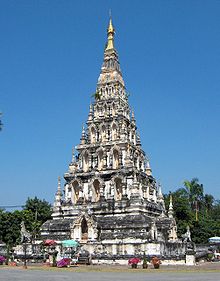Wiang Kum Kam

Wiang Kum Kam (
History
Wiang Kum Kam is an ancient city (
The city was established as a new capital by the King after his victory over the
The old city was then lost from history for many years after Chiang Mai was conquered by the Burmese in 1558. There is a presumption that it was seriously flooded again at this time and was finally abandoned. The people were moved back to this area again more than 200 years later with a new community, and it was then named Chang Kham village (บ้านชั่งคำ).
In 1984, the Department of Fine Arts Unit 4 discovered remnants of the old city around Wihan Kan Thom (วิหารกานโถม) at Wat Chang Kham (วัดช้างค้ำ) and afterwards excavation was begun; since then many new remains have been found and restoration has proceeded since that time.
The main temple of the town is Wat Chedi Liam (originally Wat Ku Kham), which is still occupied by monks.
List of sites
Note that this list is definitely incomplete.
Wat Chang Kham

Wat Chang Kham (Thai: วัดช้างค้ำ; "Elephant-Propped Temple") is within the grounds of a working modern temple. It is adjacent to the Wat That Noi site. The name is derived from elephant figures supporting one of the structures.
Wat Chedi Liam / Wat Ku Kham


Wat I Khang

Wat I Khang (Thai: วัดอีค่าง; "Langurs' Temple") is a ruined 16th or 17th century temple named after the former prevalence of wild old world monkeys at the site prior to its excavation and restoration, which are known as khang in Thai. It has a large, mostly intact chedi.
Wat Nan Chang

Wat Nan Chang (Thai: วัดหนานช้าง; "Nan Chang's Temple") is a ruined 16th or 17th century temple. Excavated from 2002 to 2003, it primarily provides evidence of ancient flooding in the region, having been inundated by some 1.8 meters of sediment. It is speculated that it was built to face a now dried up route of the Ping River, a major transportation and trade route of historic periods.
Wat Phaya Mangrai

Wat Phrachao Ong Dam


Wat Phrachao Ong Dam (Thai: วัดพระเจ้าองค์ดำ; "Temple of the Black-Bodied Lord") is named after a burnt bronze Buddha image that was discovered at the site. Very close to the north-western side of Wat Phaya Mangrai.
Wat Pu Pia

Wat Pu Pia (Thai: วัดปู่เปี้ย; "Temple of Old Man Pia") is notable for its relatively good state of preservation, including some stucco work and an intact layout.
Wat That Khao

Wat That Khao (Thai: วัดธาตุขาว; "Temple of the White Reliquary) is another ruined temple from the 16th or 17th century that is named after its formerly lime-plastered chedi.
Wat That Noi

Wat That Noi (Thai: วัดธาตุน้อย; "Temple of the Little Reliquary") is another ruined temple of the area, so named because of its restricted scale.
See also
- Chiang Saen
- Haripunchai
- History of Thailand
- Lanna
